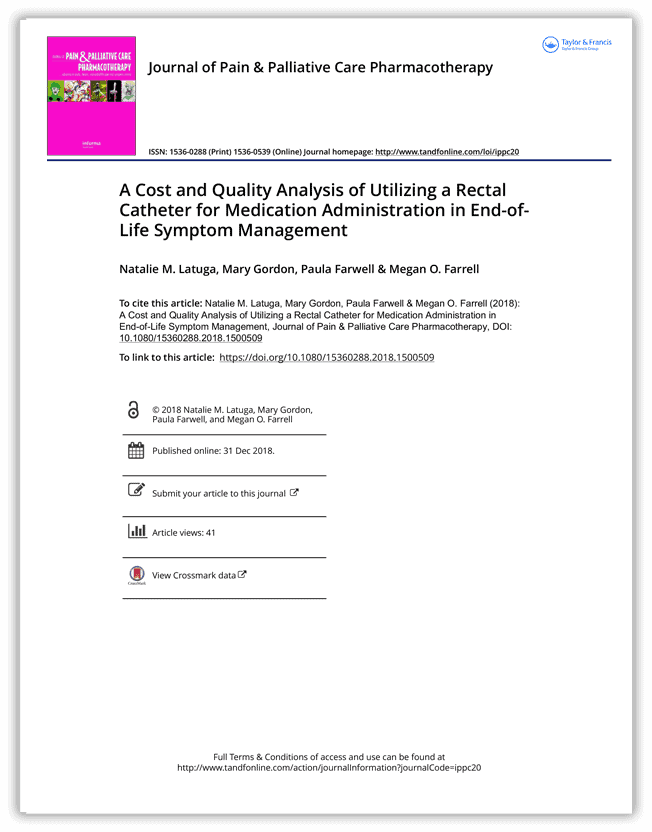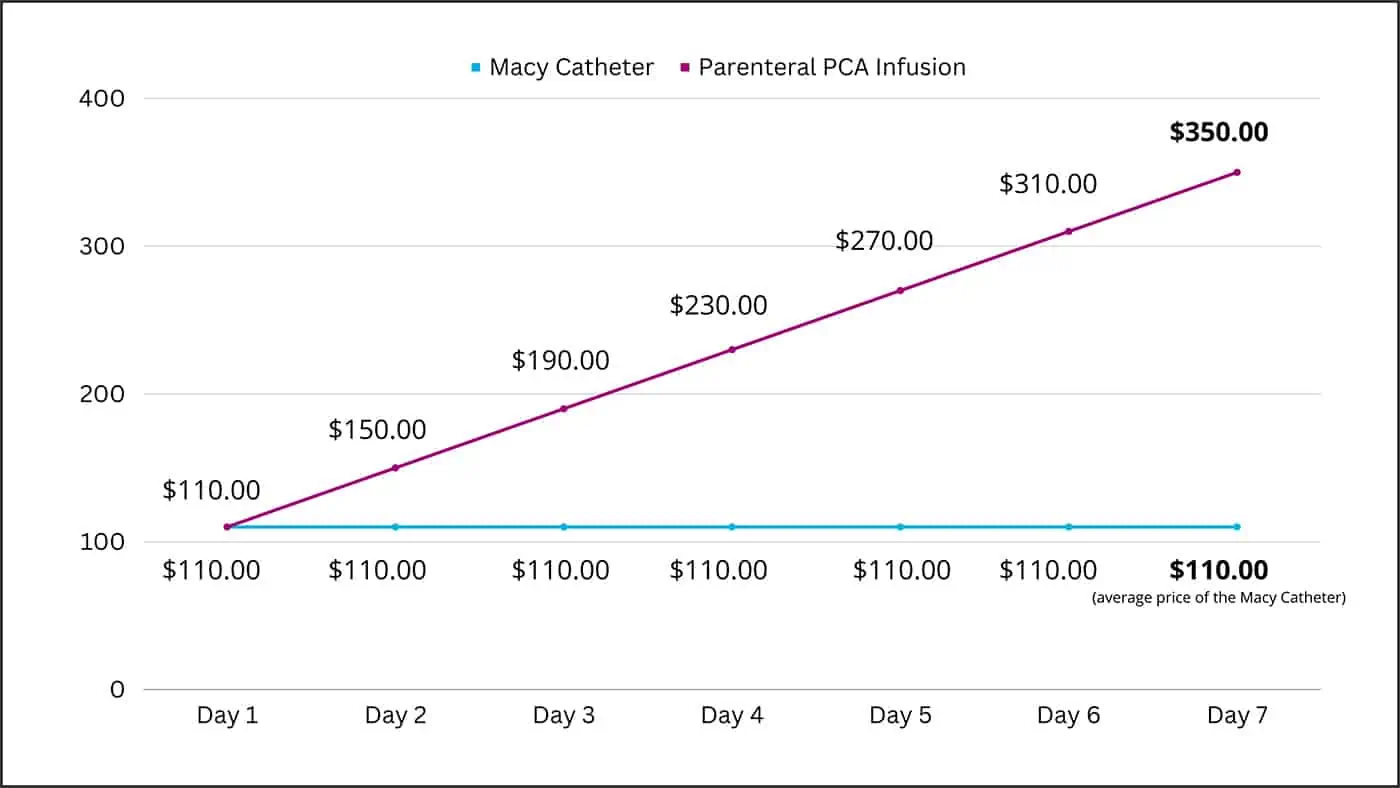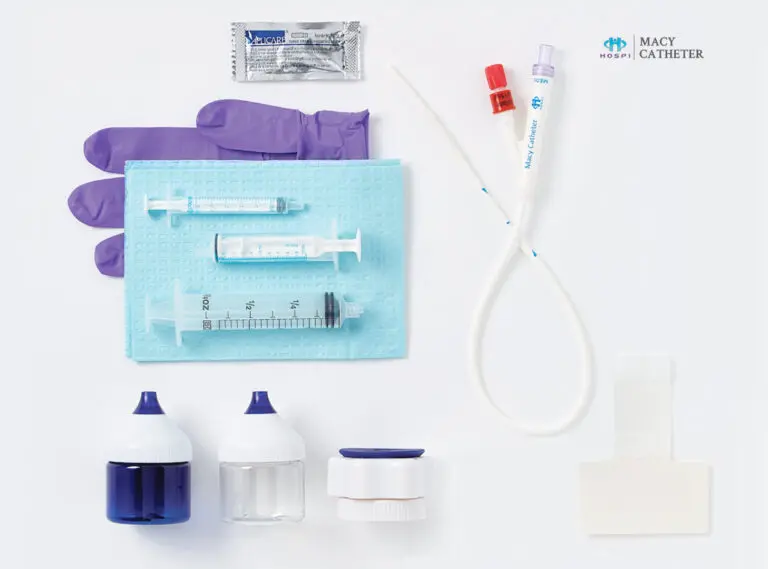Hospi Corporation received FDA clearance for the Macy Catheter in 2014. Because the Macy Catheter helps provide fast symptom management to patients, agencies who use it are able to reduce costs, mitigate staffing challenges, improve patient satisfaction/quality scores, and increase referrals.
As Hospi introduces the Macy Catheter to hospice administrators, clinicians, families, and patients across the nation, we sometimes encounter the following myths. You can skip to any section of interest:
Myth #1: The Macy Catheter is expensive.
Actually, the Macy Catheter more than pays for itself.
The Macy Catheter program will only add approximately 30 cents PPD* to medical supplies, but saves significantly more in
medication, labor, and overhead.
Without the Macy Catheter, managing severe symptoms can be an expensive and difficult endeavor.
When the oral route is compromised, many clinicians will first turn to sublingual administration. However, if sublingual doesn’t immediately work, it can become expensive due to the additional time and overhead associated with symptom chasing.

Agencies can avoid the costs and frustrations associated with symptom chasing (delivery fees, medication costs, wait times, nursing time, triage, etc.) since the Macy Catheter allows for fast management of difficult-to-control symptoms using routine oral solids and liquids readily available.
Eventually, certain patients need alternatives such as IV, SQ, transdermal, or suppositories. These alternatives require additional medication and delivery costs and cause delays in symptom control of many hours or even days.

Macy Catheter placement takes about 5 minutes and is non sterile. No delivery fees. No wait times. There is typically no associated maintenance or complications. (If the catheter is expelled during a bowel movement, reinsertion takes less than 5 minutes. Bowel movements are infrequent in patients with compromised oral routes, so we find that the catheter is only expelled in about 5% of cases.)
Hospice Buffalo reports that infusion costs include a $40/day per diem charge in addition to the cost for the medication, a delivery charge, and an additional infusion nurse visit cost if needed. Assuming a $40/day charge for the pump, a one-time $50 delivery charge, and a $20 charge for two morphine PCA (patient-controlled analgesia) cassettes that need to be changed every 4 days, the graph below compares cost for a morphine infusion over a 7-day period to the cost of oral morphine given via the Macy Catheter:

The Macy Catheter reduces agencies’ medication costs per patient day (PPD).
Hospice Buffalo implemented the Macy Catheter as the first-line alternative in their inpatient unit when a patient was unable to swallow and sublingual was ineffective. Over the first year, Hospice Buffalo increased their Macy Catheter utilization rate by 43%. As a result, their average Monthly PBM Medication Cost PPD dropped 45% from $35.52 to $19.67.
*ppd cost of the Macy Catheter = annual cost of Macy Catheters/number of patient days = approximately 20% of annual patients served*~$110 per kit/(ADC*365) = ~(ADC*$110)/(ADC*365) = ~$0.30 ppd

Still skeptical?
Contact us to let us know that you want a free cost savings estimate personalized to your agency’s data and needs. We’ll tell you exactly what kind of impact the Macy Catheter could have on your agency’s operating costs.
Myth #2: Patients and families will not accept the Macy Catheter because it’s rectal.
It’s all in the introduction.
When the Macy Catheter is properly introduced to patients and families for whom the catheter is appropriate, they readily accept it.
Nursing Educator Angie L. Ott, RN, CHPN of Unity Hospice hasn’t had a patient or family member say no to her yet. Her coworker Tara L. Kerscher, RN elaborates:
“I assumed that patients and families would possibly refuse to use it, but really with good education and rationale for the use of the catheter, it wasn’t really difficult to get the patients and families to agree to use it. Their first concern is comfort, and if we can give them an option for better comfort, then most of our patients will agree to give it a chance.”
Hospice clinicians are uniquely positioned to confidently convey recommendations to their patients and families, especially those that result in improved quality of life.
Hospice Team Director Brian Hargrave suggests that clinicians present the catheter as “an answer that may be the solution.”
During Macy Catheter training, Hospi recommends that clinicians start by identifying the problem or the reason why the Macy Catheter should be considered. If they immediately follow this identification by reassuring the patient and/or family that they have the solution and by describing the Macy Catheter with positive, descriptive terms, clinicians should encounter little to no resistance.
When we asked EveryStep Hospice’s Chief Medical Officer Dr. Tom Mouser, MD how patients and families have responded to the Macy Catheter in his experience, Dr. Mouser reported complete satisfaction:
“Unsure when they start to hear about the rectal route, the minute that it is explained and utilized, I’ve gotten feedback 100% of the time that it works great– not just from the families but from those patients that actually are able to speak to it. They don’t even notice it, they love it, and it’s taken a lot of burden off.”
After the Macy Catheter was used to help manage her sister’s symptoms, caregiver Geraldine Wolfolk called the catheter “a gift to the entire family.”
“I want to tell people who have any type of hesitation to try something new, if they haven’t tried the Macy Catheter– I want to tell them to try it. If your care provider does not have it, does not know what you are talking about, insist that they look it up. I promise you, you will be doing your loved one a favor and you will be doing yourself a favor.”
Myth #3: The Macy Catheter will burden staff.
In fact, the Macy Catheter actually empowers nurses and reduces their burden.
Work stress accumulates when nurses’ efforts to bring comfort to their patients do not yield timely results or when they require painful/invasive methods.

With the Macy Catheter, nurses are empowered to bring relief to their patients within minutes using oral medications readily available at the bedside.
Macy Catheter placement is easy and non sterile; any licensed clinician can place it. Ongoing medication administration with the Macy Catheter is so straightforward that caregivers can do it themselves.
After Hospice of the Northwest began using the Macy Catheter, Nursing Clinical Manager Kirsten Hackworth, RN, BSN, CHPN noticed that her agency was able to reduce hours of nursing time and burden:
“In the olden days, we would have gone to a pump after we couldn’t get a patient comfortable, but we don’t have to do that anymore. That’s not our next stop. Some of these cases could’ve ended up being continuous care where we would have had a nurse there all night long working on sublingual medications to get this patient comfortable. Or, we would have had to order a pump, and usually it takes us at least 4 hours to actually get a pump delivered because it has to be made up.
‘So then there’s that 4 hours during which that nurse is in that home with a patient who’s uncomfortable, just waiting for relief. ‘
‘To not have to wait that 4 hours and to be able to say ‘Alright, I’ve got this Macy Catheter,’ and just put that in and get that patient comfortable sooner… I mean, that’s what it’s all about.”
Hospice nurse Desiree Avilez, RN of Hill Country Memorial Hospice describes the Macy Catheter as a tool for nurse job satisfaction:
“It has given us something to be proud of. The staff feels more empowered. There’s really no greater feeling a nurse can have than the feeling they get knowing that they’ve provided the greatest level of palliation for their patients.”
Hospi’s implementation team will ensure that incorporating the Macy Catheter into your agency’s practice is an easy and fast process.
Hospi’s Clinical Team has developed free 30-minute training sessions for prescribers, nurses, and hospice leadership. We will work with your agency’s leadership to determine parameters for use of the Macy Catheter and to adapt the training to your agency’s needs. We have a Clinical Support Line available 24/7 (888-509-3732) and live online chat available at MacyCatheter.com. Instructional videos are available on the Macy Catheter website for on-demand review.
Myth #4: The Macy Catheter is uncomfortable.
The lubricated 14 French catheter is completely painless to insert. The Macy Catheter’s retention balloon is smaller and softer than typical stool in the rectum. Patients report that they don’t even feel the catheter in place.
The catheter was carefully designed not to stimulate the pudendal nerve, so it does not trigger a defecatory response.
Myth #5: The Macy Catheter is undignified.
The Macy Catheter was invented in order to transform the rectal route into one that is discreet and dignified. Because it’s an indwelling device, the patient’s privacy is not violated for medication administration. The medication administration port is secured to the thigh so the patient never has to be disturbed after the quick and painless initial placement of the catheter.
The Macy Catheter is much more dignified than suppositories.
Julie Salyers, BSN, RN of Fairhope Hospice agrees:
“Having to turn someone every time you give them rectal medications because they have to get the medication by that route is distressing to families because they always leave the room. You have to turn the patient, and they may be having a lot of pain that we’re trying to get under control. Immediately, the Macy Catheter just got rid of that whole situation.”
The Macy Catheter requires no turning or repositioning of the patient and no interruption of their time with family during medication administration.
“Because of the Macy Catheter, we’ve got married couples who’ve been married for 70+ years holding hands and never leaving each other’s sides. We want to give them as much time as possible. It could be the last 10 minutes that they have together.”
–Philena Brandt, RN
Is sublingual administration dignified?
Dr. Tom Mouser, MD–Chief Medical Officer of EveryStep Hospice–explains that sublingual administration is only dignified to a certain point. Symptom chasing via sublingual administration can lead to unfavorable outcomes like excessive respiratory noise.
“Respiratory noise is not a pleasant sound. When we hear respiratory noise and we know that that’s because people are not swallowing and the gag reflex is altered, the one thing that logically leads to that most of the time is the liquid medications and crushed medications we’re trying to give.
‘The loss of dignity in watching somebody, listening to somebody go through that far trumps and outweighs the theoretical loss of dignity related to something that they don’t even know is there because they can’t feel it.”
Melissa Snodgrass-Wold, LPN agrees with Dr. Mouser. She explains why she finds the Macy Catheter to be more dignified than sublingual administration:
“The taste of these medications is awful, just awful. Another thing to wrap your head around is: here they are at the end of life and you’re putting all these disgusting medications that are just sitting in their mouths. They’re not able to swallow anything to try to wash it out.
‘With the Macy Catheter, it’s no longer a fight trying to get these mediations in orally. There are no medications coming out all over or combative patients who can’t do the taste anymore. The patients are accepting and so much more comfortable and the families are just so relieved.”
Is IV/SubQ administration dignified?
When a patient’s extremities are tethered to lines, it is difficult for them to caress their loved ones. The environment is highly medicalized, and the patient and their family time is interrupted for maintenance.
After experiencing the environment that subcutaneous CADD pumps create for the patients and families firsthand, Tara L. Kerscher, RN of Unity Hospice finds the pumps “disturbing”:
“When you’re there and you have that 4 hours of constant interruption with the CADD pump… Going in every 20 minutes, you have to displace the family and turn on the lights. The beeping of the CADD is terribly disturbing and interrupts the time that the family is spending with the patient, and you have to have two nurses to check off all your dosing. The patient has to move so that we can come in and adjust these pumps.
‘When we switched to the Macy Catheter, I could just come in by myself. We drew everything up in the other room. We just came in with the syringe and flush and snuck along the side because the catheter is down further on the leg, not up higher. It’s quiet; you just push it in. We’re very unnoticeable.”
Myth #6: The Macy Catheter cannot be used for ambulatory patients.

The Macy Catheter has been utilized by many ambulatory patients in order to achieve end of life goals. One of the biggest benefits of the Macy Catheter is the fact that it can be used to help manage symptoms for patients while leaving extremities untethered. Patients can remain active if they so choose. Because patients are not tethered to lines and don’t have needles in them, the Macy Catheter does not encumber soothing hugs and embraces.

One patient worked with his family to plan a celebration of life for himself that he could attend, but it was three hours away. He kept the Macy Catheter in place so he could administer medications and fluids himself as he drove his motorcycle to the event. After the celebration, he discontinued hydration and was able to pass peacefully. Another patient with a bowel obstruction used the Macy Catheter to remain hydrated while on a final Disneyland trip with her grandchildren.
A gastroparesis patient had a long history of medications clogging up her J-Tube and was frustrated with the inconvenience and discomfort associated with going to the Emergency Department regularly to get it replaced. After a nurse introduced the Macy Catheter to the patient and to her husband, the patient reported that her pain and nausea was better controlled than it ever was using the J-tube. Her husband is comfortable giving her medications via the catheter, and the patient continues to use the Macy Catheter with success.


